Hi Everybody!!
Happy Holiday for those celebrating. Tonight I bring You a parade of baby Cardinals! Yes, we are rich with baby birds around the Sanctuary. On Christmas Day, three pairs of Cardinals came to live here. Now they all have at least 3 babies each. They hatch out featherless and grow brown down first. Then they begin to get spots of color. About another week and they have the first set of feathers on. The parents bring the babies to the feeding stations to learn to eat seed. This is a great communal time around here with babies everywhere and all kinds of singing going on. Smile, Your on Candid Camera! Enjoy!
http://en.wikipedia.org/wiki/Bird
Bird
From Wikipedia, the free encyclopedia
Birds (class Aves) are feathered, winged, bipedal, endothermic (warm-blooded), egg-laying, vertebrate animals. With around 10,000 living species, they are the most speciose class of tetrapod vertebrates. All present species belong to the subclass Neornithes, and inhabit ecosystems across the globe, from the Arctic to the Antarctic.Extant birds range in size from the 5 cm (2 in) Bee Hummingbird to the 2.75 m (9 ft) Ostrich. The fossil recordindicates that birds emerged within theropod dinosaurs during the Jurassic period, around 150 million years ago.Paleontologists regard birds as the only clade of dinosaurs to have survived the Cretaceous–Paleogene extinction event 66 million years ago.
Modern birds are characterised by feathers, a beak with no teeth, the laying of hard-shelled eggs, a high metabolicrate, a four-chambered heart, and a lightweight but strong skeleton. All living species of birds have wings; the most recent species without wings was the moa, which is generally considered to have become extinct in the 16th century. Wings are evolved forelimbs, and most bird species can fly. Flightless birds include ratites, penguins, and a number of diverse endemic island species. Birds also have unique digestive and respiratory systems that are highly adapted for flight. Some birds, especially corvids and parrots, are among the most intelligent animal species; a number of bird species have been observed manufacturing and using tools, and many social species exhibit cultural transmission of knowledge across generations.
Many species undertake long distance annual migrations, and many more perform shorter irregular movements. Birds are social; they communicate using visual signals and through calls and songs, and participate in social behaviours, including cooperative breeding and hunting, flocking, and mobbing of predators. The vast majority of bird species are socially monogamous, usually for one breeding season at a time, sometimes for years, but rarely for life. Other species have polygynous ("many females") or, rarely, polyandrous ("many males") breeding systems. Eggs are usually laid in a nest and incubated by the parents. Most birds have an extended period of parental care after hatching.
Many species are of economic importance, mostly as sources of food acquired through hunting or farming. Some species, particularly songbirds and parrots, are popular as pets. Other uses include the harvesting of guano(droppings) for use as a fertiliser. Birds figure prominently in all aspects of human culture from religion to poetry to popular music. About 120–130 species have become extinct as a result of human activity since the 17th century, and hundreds more before then. Currently about 1,200 species of birds are threatened with extinction by human activities, though efforts are underway to protect them.
Anatomy and physiology
Main articles: Bird anatomy and Bird vision
Compared with other vertebrates, birds have a body plan that shows many unusual adaptations, mostly to facilitate flight.
The skeleton consists of very lightweight bones. They have large air-filled cavities (called pneumatic cavities) which connect with the respiratory system.[41] The skull bones in adults are fused and do not show cranial sutures.[42] The orbits are large and separated by a bony septum. The spine has cervical, thoracic, lumbar and caudal regions with the number of cervical (neck) vertebrae highly variable and especially flexible, but movement is reduced in the anterior thoracic vertebrae and absent in the later vertebrae.[43] The last few are fused with the pelvis to form the synsacrum.[42] The ribs are flattened and the sternum is keeled for the attachment of flight muscles except in the flightless bird orders. The forelimbs are modified into wings.[44]
Like the reptiles, birds are primarily uricotelic, that is, their kidneys extract nitrogenous wastes from their bloodstream and excrete it as uric acid instead of urea or ammonia via the ureters into the intestine. Birds do not have a urinary bladder or external urethral opening and (with exception of theOstrich) uric acid is excreted along with feces as a semisolid waste.[45][46][47] However, birds such as hummingbirds can be facultatively ammonotelic, excreting most of the nitrogenous wastes as ammonia.[48] They also excrete creatine, rather than creatinine like mammals.[42] This material, as well as the output of the intestines, emerges from the bird's cloaca.[49][50] The cloaca is a multi-purpose opening: waste is expelled through it, most birds mate by joining cloaca, and females lay eggs from it. In addition, many species of birds regurgitate pellets.[51] Many waterfowl and some other birds, such as the ostrich and turkey, possess a penis. The length is thought to be related to sperm competition.[52] When not copulating, it is hidden within the proctodeum compartment within the cloaca, just inside the vent. The digestive system of birds is unique, with a crop for storage and a gizzard that contains swallowed stones for grinding food to compensate for the lack of teeth.[53] Most birds are highly adapted for rapid digestion to aid with flight.[54] Some migratory birds have adapted to use protein from many parts of their bodies, including protein from the intestines, as additional energy during migration.[55]
Birds have one of the most complex respiratory systems of all animal groups.[42] Upon inhalation, 75% of the fresh air bypasses the lungs and flows directly into a posterior air sac which extends from the lungs and connects with air spaces in the bones and fills them with air. The other 25% of the air goes directly into the lungs. When the bird exhales, the used air flows out of the lung and the stored fresh air from the posterior air sac is simultaneously forced into the lungs. Thus, a bird's lungs receive a constant supply of fresh air during both inhalation and exhalation.[56] Sound production is achieved using the syrinx, a muscular chamber incorporating multiple tympanic membranes which diverges from the lower end of the trachea;[57] the trachea being elongated in some species, increasing the volume of vocalizations and the perception of the bird's size.[58] The bird's heart has four chambers like a mammalian heart. In birds the main arteries taking blood away from the heart originate from the right aortic arch (or pharyngeal arch), unlike in the mammals where the left aortic arch forms this part of the aorta.[42] The postcava receives blood from the limbs via the renal portal system. Unlike in mammals, the circulating red blood cells in birds retain their nucleus.[59]
The nervous system is large relative to the bird's size.[42] The most developed part of the brain is the one that controls the flight-related functions, while the cerebellum coordinates movement and thecerebrum controls behaviour patterns, navigation, mating and nest building. Most birds have a poorsense of smell with notable exceptions including kiwis,[60] New World vultures[61] and tubenoses.[62]The avian visual system is usually highly developed. Water birds have special flexible lenses, allowing accommodation for vision in air and water.[42] Some species also have dual fovea. Birds aretetrachromatic, possessing ultraviolet (UV) sensitive cone cells in the eye as well as green, red and blue ones.[63] This allows them to perceive ultraviolet light, which is involved in courtship. Many birds show plumage patterns in ultraviolet that are invisible to the human eye; some birds whose sexes appear similar to the naked eye are distinguished by the presence of ultraviolet reflective patches on their feathers. Male Blue Tits have an ultraviolet reflective crown patch which is displayed in courtship by posturing and raising of their nape feathers.[64] Ultraviolet light is also used in foraging—kestrels have been shown to search for prey by detecting the UV reflective urine trail marks left on the ground by rodents.[65] The eyelids of a bird are not used in blinking. Instead the eye is lubricated by the nictitating membrane, a third eyelid that moves horizontally.[66] The nictitating membrane also covers the eye and acts as a contact lens in many aquatic birds.[42] The bird retina has a fan shaped blood supply system called the pecten.[42] Most birds cannot move their eyes, although there are exceptions, such as the Great Cormorant.[67] Birds with eyes on the sides of their heads have a wide visual field, while birds with eyes on the front of their heads, such as owls, have binocular vision and can estimate the depth of field.[68] The avian ear lacks external pinnae but is covered by feathers, although in some birds, such as the Asio, Bubo and Otus owls, these feathers form tufts which resemble ears. The inner ear has a cochlea, but it is not spiral as in mammals.[69]
A few species are able to use chemical defenses against predators; some Procellariiformes can eject an unpleasant oil against an aggressor,[70] and some species of pitohuis from New Guinea have a powerful neurotoxin in their skin and feathers.[71]
Flight
Main article: Bird flight
Most birds can fly, which distinguishes them from almost all other vertebrate classes. Flight is the primary means of locomotion for most bird species and is used for breeding, feeding, and predator avoidance and escape. Birds have various adaptations for flight, including a lightweight skeleton, two large flight muscles, the pectoralis (which accounts for 15% of the total mass of the bird) and the supracoracoideus, as well as a modified forelimb (wing) that serves as an aerofoil.[42] Wing shape and size generally determine a bird species' type of flight; many birds combine powered, flapping flight with less energy-intensive soaring flight. About 60 extant bird species are flightless, as were many extinct birds.[86]Flightlessness often arises in birds on isolated islands, probably due to limited resources and the absence of land predators.[87] Though flightless, penguins use similar musculature and movements to "fly" through the water, as doauks, shearwaters and dippers.[88]
Territories, nesting and incubation
See also: Bird nest
Many birds actively defend a territory from others of the same species during the breeding season; maintenance of territories protects the food source for their chicks. Species that are unable to defend feeding territories, such as seabirds and swifts, often breed in colonies instead; this is thought to offer protection from predators. Colonial breeders defend small nesting sites, and competition between and within species for nesting sites can be intense.[155]
All birds lay amniotic eggs with hard shells made mostly of calcium carbonate.[42] Hole and burrow nesting species tend to lay white or pale eggs, while open nesters lay camouflaged eggs. There are many exceptions to this pattern, however; the ground-nesting nightjars have pale eggs, and camouflage is instead provided by their plumage. Species that are victims of brood parasites have varying egg colours to improve the chances of spotting a parasite's egg, which forces female parasites to match their eggs to those of their hosts.[156]
Bird eggs are usually laid in a nest. Most species create somewhat elaborate nests, which can be cups, domes, plates, beds scrapes, mounds, or burrows.[157] Some bird nests, however, are extremely primitive; albatross nests are no more than a scrape on the ground. Most birds build nests in sheltered, hidden areas to avoid predation, but large or colonial birds—which are more capable of defence—may build more open nests. During nest construction, some species seek out plant matter from plants with parasite-reducing toxins to improve chick survival,[158] and feathers are often used for nest insulation.[157] Some bird species have no nests; the cliff-nesting Common Guillemot lays its eggs on bare rock, and male Emperor Penguins keep eggs between their body and feet. The absence of nests is especially prevalent in ground-nesting species where the newly hatched young are precocial.
Incubation, which optimises temperature for chick development, usually begins after the last egg has been laid.[42] In monogamous species incubation duties are often shared, whereas in polygamous species one parent is wholly responsible for incubation. Warmth from parents passes to the eggs through brood patches, areas of bare skin on the abdomen or breast of the incubating birds. Incubation can be an energetically demanding process; adult albatrosses, for instance, lose as much as 83 grams (2.9 oz) of body weight per day of incubation.[159] The warmth for the incubation of the eggs of megapodes comes from the sun, decaying vegetation or volcanic sources.[160] Incubation periods range from 10 days (in woodpeckers, cuckoos and passerine birds) to over 80 days (in albatrosses and kiwis).[42]
Parental care and fledging
At the time of their hatching, chicks range in development from helpless to independent, depending on their species. Helpless chicks are termed altricial, and tend to be born small, blind, immobile and naked; chicks that are mobile and feathered upon hatching are termed precocial. Altricial chicks need help thermoregulating and must be brooded for longer than precocial chicks. Chicks at neither of these extremes can be semi-precocial or semi-altricial.
The length and nature of parental care varies widely amongst different orders and species. At one extreme, parental care in megapodes ends at hatching; the newly hatched chick digs itself out of the nest mound without parental assistance and can fend for itself immediately.[161] At the other extreme, many seabirds have extended periods of parental care, the longest being that of the Great Frigatebird, whose chicks take up to six months to fledge and are fed by the parents for up to an additional 14 months.[162] The chick guard stage describes the period of breeding during which one of the adult birds is permanently present at the nest after chicks have hatched. The main purpose of the guard stage is to aid offspring to thermoregulate and protect them from predation.[163]
In some species, both parents care for nestlings and fledglings; in others, such care is the responsibility of only one sex. In some species, other members of the same species—usually close relatives of the breeding pair, such as offspring from previous broods—will help with the raising of the young.[164] Such alloparenting is particularly common among the Corvida, which includes such birds as the true crows, Australian Magpie and Fairy-wrens,[165] but has been observed in species as different as the Rifleman and Red Kite. Among most groups of animals, male parental care is rare. In birds, however, it is quite common—more so than in any other vertebrate class.[42] Though territory and nest site defence, incubation, and chick feeding are often shared tasks, there is sometimes a division of labour in which one mate undertakes all or most of a particular duty.[166]
The point at which chicks fledge varies dramatically. The chicks of the Synthliboramphus murrelets, like the Ancient Murrelet, leave the nest the night after they hatch, following their parents out to sea, where they are raised away from terrestrial predators.[167] Some other species, such as ducks, move their chicks away from the nest at an early age. In most species, chicks leave the nest just before, or soon after, they are able to fly. The amount of parental care after fledging varies; albatross chicks leave the nest on their own and receive no further help, while other species continue some supplementary feeding after fledging.[168] Chicks may also follow their parents during their first migration.[169]
...this is brendasue signing off from Rainbow Creek. See You next time. Try to have a good week.
(Learn some stuff!) Love Ya!!
O+O

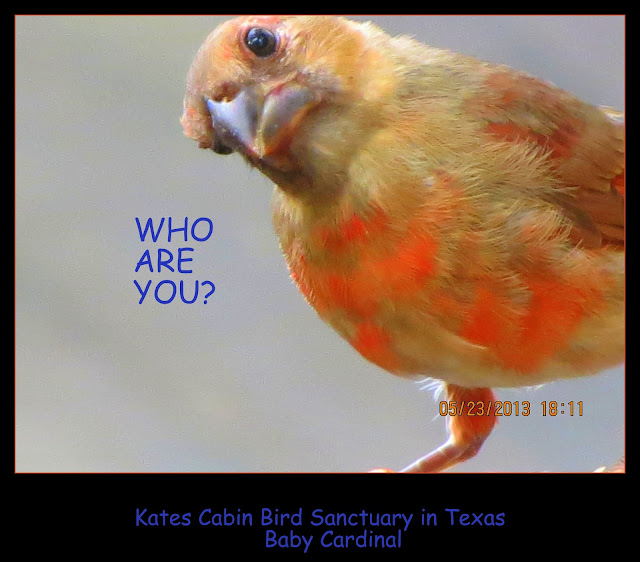



















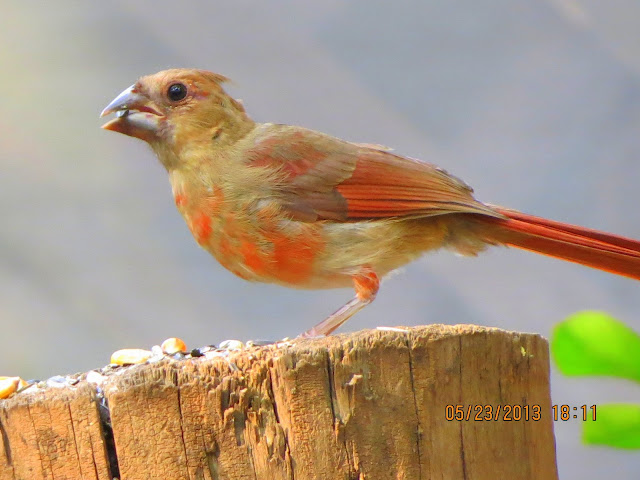














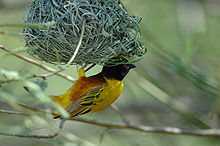
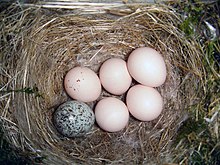
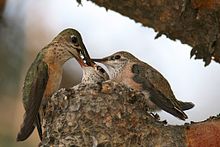





No comments:
Post a Comment
Hi Everybody! Please say hello and follow so I know you are here! Due to the inconsideration of people trying to put commercials on my blog comment area, I have restricted use of anonymous posts. Sorry that some hurt all.
My public email is katescabin@gmail.com No spammers or trolls